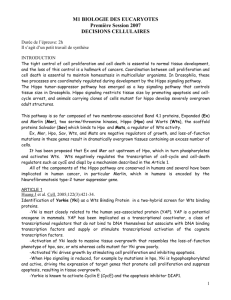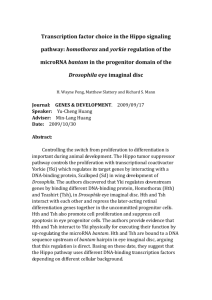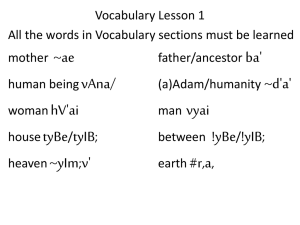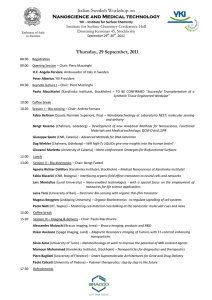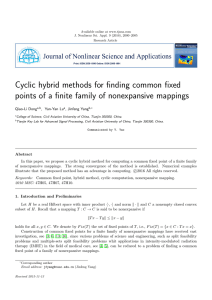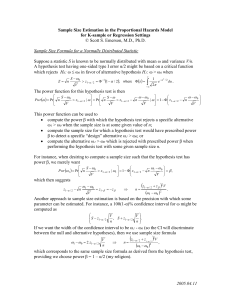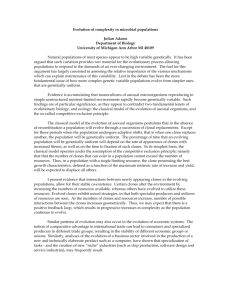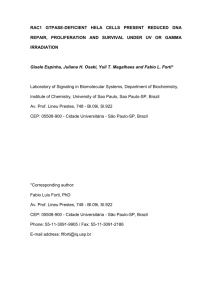Article
advertisement
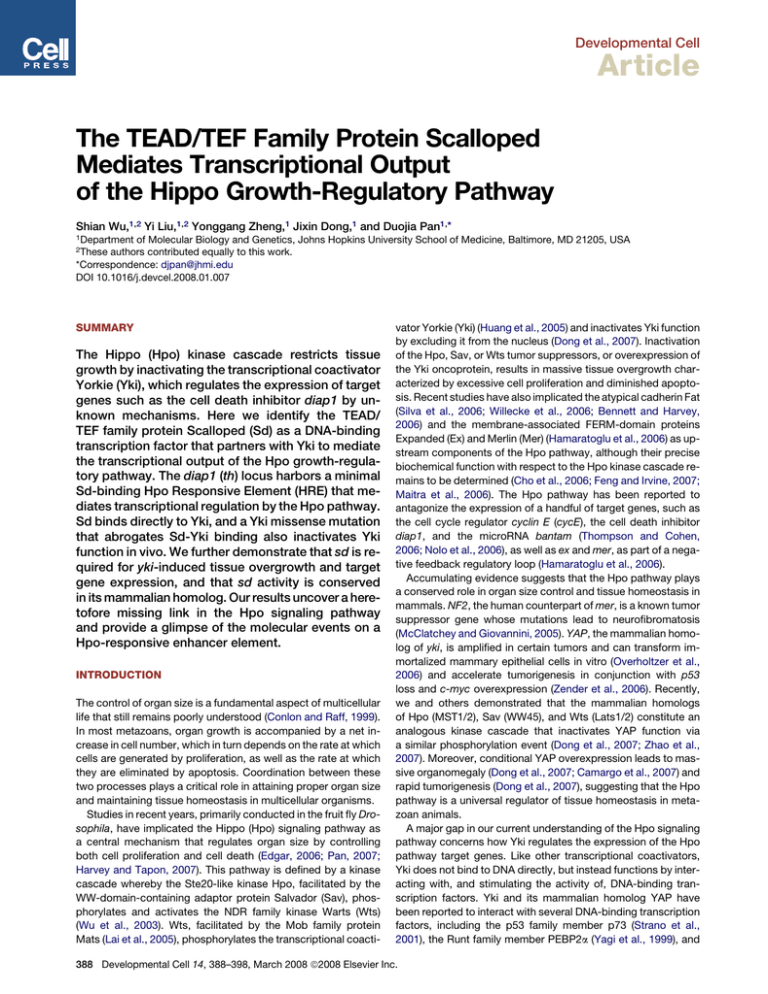
Developmental Cell Article The TEAD/TEF Family Protein Scalloped Mediates Transcriptional Output of the Hippo Growth-Regulatory Pathway Shian Wu,1,2 Yi Liu,1,2 Yonggang Zheng,1 Jixin Dong,1 and Duojia Pan1,* 1Department of Molecular Biology and Genetics, Johns Hopkins University School of Medicine, Baltimore, MD 21205, USA authors contributed equally to this work. *Correspondence: djpan@jhmi.edu DOI 10.1016/j.devcel.2008.01.007 2These SUMMARY The Hippo (Hpo) kinase cascade restricts tissue growth by inactivating the transcriptional coactivator Yorkie (Yki), which regulates the expression of target genes such as the cell death inhibitor diap1 by unknown mechanisms. Here we identify the TEAD/ TEF family protein Scalloped (Sd) as a DNA-binding transcription factor that partners with Yki to mediate the transcriptional output of the Hpo growth-regulatory pathway. The diap1 (th) locus harbors a minimal Sd-binding Hpo Responsive Element (HRE) that mediates transcriptional regulation by the Hpo pathway. Sd binds directly to Yki, and a Yki missense mutation that abrogates Sd-Yki binding also inactivates Yki function in vivo. We further demonstrate that sd is required for yki-induced tissue overgrowth and target gene expression, and that sd activity is conserved in its mammalian homolog. Our results uncover a heretofore missing link in the Hpo signaling pathway and provide a glimpse of the molecular events on a Hpo-responsive enhancer element. INTRODUCTION The control of organ size is a fundamental aspect of multicellular life that still remains poorly understood (Conlon and Raff, 1999). In most metazoans, organ growth is accompanied by a net increase in cell number, which in turn depends on the rate at which cells are generated by proliferation, as well as the rate at which they are eliminated by apoptosis. Coordination between these two processes plays a critical role in attaining proper organ size and maintaining tissue homeostasis in multicellular organisms. Studies in recent years, primarily conducted in the fruit fly Drosophila, have implicated the Hippo (Hpo) signaling pathway as a central mechanism that regulates organ size by controlling both cell proliferation and cell death (Edgar, 2006; Pan, 2007; Harvey and Tapon, 2007). This pathway is defined by a kinase cascade whereby the Ste20-like kinase Hpo, facilitated by the WW-domain-containing adaptor protein Salvador (Sav), phosphorylates and activates the NDR family kinase Warts (Wts) (Wu et al., 2003). Wts, facilitated by the Mob family protein Mats (Lai et al., 2005), phosphorylates the transcriptional coacti- vator Yorkie (Yki) (Huang et al., 2005) and inactivates Yki function by excluding it from the nucleus (Dong et al., 2007). Inactivation of the Hpo, Sav, or Wts tumor suppressors, or overexpression of the Yki oncoprotein, results in massive tissue overgrowth characterized by excessive cell proliferation and diminished apoptosis. Recent studies have also implicated the atypical cadherin Fat (Silva et al., 2006; Willecke et al., 2006; Bennett and Harvey, 2006) and the membrane-associated FERM-domain proteins Expanded (Ex) and Merlin (Mer) (Hamaratoglu et al., 2006) as upstream components of the Hpo pathway, although their precise biochemical function with respect to the Hpo kinase cascade remains to be determined (Cho et al., 2006; Feng and Irvine, 2007; Maitra et al., 2006). The Hpo pathway has been reported to antagonize the expression of a handful of target genes, such as the cell cycle regulator cyclin E (cycE), the cell death inhibitor diap1, and the microRNA bantam (Thompson and Cohen, 2006; Nolo et al., 2006), as well as ex and mer, as part of a negative feedback regulatory loop (Hamaratoglu et al., 2006). Accumulating evidence suggests that the Hpo pathway plays a conserved role in organ size control and tissue homeostasis in mammals. NF2, the human counterpart of mer, is a known tumor suppressor gene whose mutations lead to neurofibromatosis (McClatchey and Giovannini, 2005). YAP, the mammalian homolog of yki, is amplified in certain tumors and can transform immortalized mammary epithelial cells in vitro (Overholtzer et al., 2006) and accelerate tumorigenesis in conjunction with p53 loss and c-myc overexpression (Zender et al., 2006). Recently, we and others demonstrated that the mammalian homologs of Hpo (MST1/2), Sav (WW45), and Wts (Lats1/2) constitute an analogous kinase cascade that inactivates YAP function via a similar phosphorylation event (Dong et al., 2007; Zhao et al., 2007). Moreover, conditional YAP overexpression leads to massive organomegaly (Dong et al., 2007; Camargo et al., 2007) and rapid tumorigenesis (Dong et al., 2007), suggesting that the Hpo pathway is a universal regulator of tissue homeostasis in metazoan animals. A major gap in our current understanding of the Hpo signaling pathway concerns how Yki regulates the expression of the Hpo pathway target genes. Like other transcriptional coactivators, Yki does not bind to DNA directly, but instead functions by interacting with, and stimulating the activity of, DNA-binding transcription factors. Yki and its mammalian homolog YAP have been reported to interact with several DNA-binding transcription factors, including the p53 family member p73 (Strano et al., 2001), the Runt family member PEBP2a (Yagi et al., 1999), and 388 Developmental Cell 14, 388–398, March 2008 ª2008 Elsevier Inc. Developmental Cell Scalloped Functions in the Hippo Signaling Pathway the TEAD/TEF family transcription factors (Vassilev et al., 2001; Giot et al., 2003). However, it remains to be determined whether any of these proteins, or any of the other unknown proteins, is the relevant partner for Yki in the context of the Hpo growth-regulatory pathway. Furthermore, the available genetic data do not distinguish whether the known Hpo pathway target genes are regulated by Yki directly or indirectly through intermediary transcription regulators that are themselves induced by Yki. Answers to these questions require identification of Hpo-responsive regulatory regions in the known target genes. Scalloped (Sd) is the only TEAD/TEF family DNA-binding transcription factor in Drosophila (Campbell et al., 1992). Much of what we know about Sd comes from studies in the Drosophila wing, where Sd interacts with the Vestigial (Vg) protein to form a transcription factor complex that promotes wing blade development (Simmonds et al., 1998; Halder et al., 1998). Vg does not bind DNA but acts exclusively by binding to Sd and providing coactivator function for the Sd-Vg complex. Transcriptional targets of the Sd-Vg complex include sd and vg themselves, and other genes such as distalless (Simmonds et al., 1998; Halder et al., 1998; Liu et al., 2000). sd and vg are both expressed and required for the survival of wing blade cells, and sd or vg clones fail to grow within the wing blade, but grow normally in the wing hinge and notum (Liu et al., 2000; Kim et al., 1996). Despite these similarities, there is a fundamental dichotomy between sd and vg—while vg is only expressed in the wing imaginal disc (Williams et al., 1991), sd is expressed in multiple tissues during embryonic and larval development (Campbell et al., 1992), suggesting that Sd can partner with non-Vg coactivators in tissues outside the wing blade. The identity of such a coactivator or coactivators is currently unknown. In the current study, we identify the DNA-binding transcription factor that partners with Yki to mediate the transcriptional output of the Hpo pathway. First, we defined a minimal enhancer element that confers Hpo-responsive regulation of a known Hpo pathway target gene, and identified a sequence-specific transcription factor that binds to this DNA element. Second, we defined a functional domain within the Yki protein that mediates its interaction with its DNA-binding partner, and identified a protein that binds this domain. Both approaches converged to reveal Sd as a DNA-binding factor that mediates the transcriptional output of the Hpo pathway. sd is required for yki-induced tissue overgrowth and target gene expression, and the activity of sd is conserved in its mammalian homolog. Our studies therefore uncover an important missing link in the Hpo signaling pathway. RESULTS Dissection of the diap1 (th) Locus Reveals a Minimal Hpo Responsive Element, or HRE In order to gain a mechanistic understanding of how the Hpo pathway regulates the expression of target genes, we first sought to dissect the Hpo pathway-responsive regulatory elements of a representational Hpo pathway target gene. Among the beststudied Hpo pathway targets—cycE, diap1, and the microRNA bantam—we focused on diap1 since its regulation by the Hpo pathway is more robust and ubiquitous in the eye imaginal discs than that of cycE (Wu et al., 2003; Huang et al., 2005), and microRNA promoters are less well defined than those of protein-coding genes (Kim and Nam, 2006). The diap1 gene contains a single coding exon, which can be alternatively spliced with one of three possible upstream exons to generate RA, RB, or RC transcript (Figure 1A), with RA being the predominant form throughout all stages of Drosophila development (Flybase: http://flybase.bio.indiana.edu/). To map the enhancer element or elements within the diap1 gene that confer Hpo-responsive transcriptional regulation, we cloned genomic DNA fragments surrounding the diap1 locus upstream of the hsp70 basal promoter and a lacZ reporter in an enhancer-detection P element vector (Wharton and Crews, 1993). Reporter expression was examined in the eye imaginal discs to identify the fragment that showed elevated lacZ expression in hpo loss-of-function clones. Once a Hpo-responsive DNA fragment was identified, it was further divided and tested to narrow down the Hpo-responsive region. Interestingly, we found that DNA sequence within the intron of the RA transcript (construct 2), but not DNA sequence 50 to the transcription start site (construct 1), confers Hpo responsiveness (Figures 1B–1C0 ). After three additional rounds of reiterative subdivision, we mapped the Hpo-responsive region to an 300 bp fragment (construct 2B2C; Figures 1D and 1D0 ) within the intron of the RA transcript. Inspection of the 300 bp Hpo-responsive region revealed two stretches of DNA sequences (36 bp and 32 bp) that are highly conserved between D. melanogaster and D. pseudoobscura (Figure 2A), two Drosophila species that diverged 25–55 million years ago (Richards et al., 2005). Next, we cloned two copies of each conserved DNA stretch into the enhancer-detection vector and tested their ability to confer Hpo responsiveness. While a lacZ reporter driven by the 36 bp sequence (2B2C1) was unresponsive to loss of hpo (Figures 2B and 2B0 ), a lacZ reporter driven by the 32 bp (2B2C2) was upregulated in hpo mutant clones (Figures 2C and 2C0 ), thus pinpointing the 32 bp sequence as a HRE. We further scanned the 32 bp HRE by testing a series of reporter constructs, each containing a dimer of HRE sequence that mutates different sets of 5 or 6 bp across the 32 bp sequence (Figures 2A and 2D–2E0 ). We found that except for the first 6 nucleotides, any 5 or 6 bp substitutions for the rest of the 32 bp sequence resulted in inactivation of HRE activity, thus defining a 26 bp sequence as the minimal HRE (Figures 2A and 2D–2E0 ). Sd Binds to the HRE and Regulates HRE Activity in Conjunction with Yki Examination of the HRE revealed the existence of a CATTCCA sequence (Figure 2A), which perfectly matches the mammalian TEAD/TEF family transcription factor consensus binding motif (Xiao et al., 1991; Larkin and Ordahl, 1999). Since Sd is the sole TEAD/TEF family transcription factor in Drosophila, we tested the possibility that Sd could bind to the HRE. Indeed, bacterially purified Sd protein bound avidly to the HRE in a gel shift assay (Figure 2F). This protein-DNA interaction is specific, since it was competed away by unlabeled HRE, or HREs that carried mutations outside the CATTCCA motif (m1–m4), but not by HREs that mutated the CATTCCA motif (m5 and m6) (Figure 2F). Thus, Sd binds specifically to the CATTCCA motif within the HRE. Consistent with the competition assay, we found that labeled HRE or HRE mutants m1–m4, but not m5 and m6, bound to Sd protein in the gel shift assay (see Figure S1 in the Supplemental Data available with this article online). Taken together, these results reveal a direct binding between Sd and HRE and Developmental Cell 14, 388–398, March 2008 ª2008 Elsevier Inc. 389 Developmental Cell Scalloped Functions in the Hippo Signaling Pathway Figure 1. Dissection of HRE in the diap1 Locus (A) Schematic representation of the diap1 locus and genomic DNA fragments tested for HRE activity. At the top, filled box represents the single coding exon of diap1, empty boxes represent the first exon of alternative transcripts RA, RB, or RC, and arrow indicates the transcription start site of transcript RA. Also shown are the relative positions of the neighboring genes, Mbs and CG5895. All HREcontaining constructs are shown in red lines. (B–D0 ) Representational data from the HRE dissection experiment. Two images of third-instar eye discs are shown for each construct. hpo mutant cells are marked by lack of GFP (green; B, C, and D), and lacZ expression is shown in red (B0 , C0 , and D0 ). Representative clones are indicated by arrows. (B and B0 ) Construct 1. Note the similar level of lacZ expression in hpo mutant clones compared to the surrounding wild-type cells. (C and C0 ) Construct 2. Note the elevated level of lacZ expression in hpo mutant clones. (D and D0 ) Construct 2B2C. lacZ expression is elevated in hpo mutant clones. further suggest that additional transcription factors likely interact with HRE by binding to sequences outside of the CATTCCA motif. To further corroborate the function of the HRE in transcriptional regulation, we conducted a cell-based transcription assay using a luciferase reporter driven by the HRE. While neither Sd nor Yki activated the HRE-luciferase reporter in S2R+ cells, coexpression of Sd and Yki substantially activated the HRE reporter (Figure 2G). Mutation of the Sd-binding site (CATTCCA) abolished the activation of the HRE-luciferase reporter by Sd-Yki (Figure 2G). These results are consistent with a model wherein Sd recruits Yki to the HRE and thus regulates the expression of diap1. A prediction of this model is that the HRE should be responsive to Yki overexpression in vivo. Indeed, a reporter construct that contains a single copy of the minimal 26 bp HRE was induced by Yki overexpression in both the eye and the wing imaginal discs (Figure S2). Thus, the diap1 HRE exhibits widespread activity across multiple tissues. Unbiased Identification of Sd as a Yki-Binding Protein Concomitant with the ‘‘bottom-up’’ approach to identifying the DNA-binding factor that mediates the transcriptional output of the Hpo pathway, we also took a ‘‘top-down’’ approach to identify this protein by virtue of its physical association with Yki. For this purpose, we first sequenced a collection of yki mutant alleles generated by ethane methyl sulfonate (EMS) mutagenesis, hoping to define a region of Yki that is required for its interaction with its putative DNA-binding partner. Besides a nonsense mutation that truncates Yki after the first WW domain (R310X), our analysis revealed six missense mutations that disrupt Yki function (Figure 3A). While five out of the six mutations (E271K, Y282N, P295S, G347R, and F351I) changed evolutionarily conserved residues in the two WW domains, the remaining mutation (P88L) changes a conserved residue in the N-terminal region of Yki (Figure 3A). Like the WW domains, the sequence surrounding P88 is evolutionarily conserved, and represents the only extended sequence similarity between Yki and its mammalian homolog YAP outside the WW domains (Figure 3A). We refer to this region as the N-terminal homology (NH) domain. Since the WW domains of Yki are known to bind to the Wts kinase (Huang et al., 2005), we hypothesized that the NH domain, which encompasses the critical P88 residue, might mediate an aspect of Yki function other than Wts-binding, such as the association of Yki with a cognate DNA-binding partner. Based on structure-function relationship derived from the analysis of yki mutant alleles, we conducted a yeast two-hybrid 390 Developmental Cell 14, 388–398, March 2008 ª2008 Elsevier Inc. Developmental Cell Scalloped Functions in the Hippo Signaling Pathway Figure 2. Identification of a Minimal HRE for the diap1 Gene (A) Further dissection of 2B2C. Shown at the top is schematic representation of sequence similarity between D. melanogaster and D. pseudoobscura across the 300 bp DNA sequence of 2B2C. Note the presence of two conserved stretches, 2B2C1 (36 bp) and 2B2C2 (32 bp). The DNA sequences of wild-type 2B2C2 and the scanning mutants m1–m6, as well as their HRE activity in vivo and Sd-binding activity in vitro, are also shown. The boxed sequence within wild-type 2B2C2 shows the CATTCCA motif. (B–E0 ) Representational data from the dissection experiment. Two images of third-instar eye discs are shown for each construct. hpo mutant cells are marked by lack of GFP (green; B, C, D, and E), and lacZ expression is shown in red (B0 , C0 , D0 , and E0 ). Representative clones are indicated by arrows. (B and B0 ) Construct 2B2C1. Note the similar level of lacZ expression in hpo mutant clones compared to the surrounding wild-type cells. (C and C0 ) Construct 2B2C2. Note the elevated level of lacZ expression in hpo mutant clones. (D and D0 ) Construct 2B2Cm1. lacZ expression is elevated in hpo mutant clones. (E and E0 ) Construct 2B2Cm6. lacZ expression is similar in hpo mutant clones and the neighboring wildtype cells. (F) Specific binding between Sd and HRE. Biotinlabeled HRE (2B2C2) was incubated with bacterially purified His-Sd protein in Electrophoretic Mobility Shift Assays (EMSA). The DNA-protein complex (lane 2) was effectively competed away by 200-fold excess of unlabeled wild-type HRE (lane 3), as well as mutants m1, m2, m3, and m4 (lanes 6 through 9), but not by unlabeled mutants m5 and m6 (lanes 4 and 5). Note m5 and m6, but not m1–m4, disrupt the CATTCCA motif (Figure 2A). (G) Sd-dependent and Yki-dependent activation of HRE in S2R+ cells. Note that Sd or Yki alone had little effect on the HRE-luciferase reporter, while coexpression of Sd and Yki substantially activated the reporter. Also note that a mutant HRE (m6) carrying a mutation in the CATTCCA motif (Figure 2A) could not be activated by Sd-Yki. screen for proteins that bind to the Yki NH domain. From 1.5 million cDNA clones, we isolated 7 independent cDNA clones representing partial sequences of Sd (Figure 3B). The overlapping sequences of these clones define Sd region 226-440, located C-terminal to its DNA-binding domain, as a Yki-binding region. Consistent with our yeast two-hybrid results, Sd and Yki coimmunoprecipitate in Drosophila S2R+ cells (Figure 3C). Interestingly, the P88L mutation identified from our EMS screen abolished the binding of Yki to Sd without affecting Yki-Wts interaction (Figures 3C and 3D). On the other hand, mutating critical residues in the WW domains abolished the binding of Yki to Wts without affecting Yki-Sd binding (Figures 3C and 3D). These results provide a molecular explanation for the YkiP88L mutation and further strengthen the physiological significance of Sd-Yki interaction. Genetic Interactions between Sd and Yki To further validate the in vivo significance of Sd-Yki binding, we tested genetic interactions between sd and yki using both gainand loss-of-function experiments. We previously showed that overexpression of yki by the GMRGal4 driver (GMR > yki) leads to increased eye size (Figure 4B) (Huang et al., 2005). On the other hand, GMR > sd eyes were smaller than wild-type (Figure 4C), possibly due to a squelching effect whereby overexpressed Sd titrates out endogenous Sd cofactors and thus causes a dominant-negative effect, as previously reported in the wing (Simmonds et al., 1998) (see also Figure 4L). Strikingly, GMR > yki+sd eyes were much larger than GMR > yki eyes (Figure 4D). Conversely, halving the dosage of yki substantially enhanced the decrease in eye size resulting from sd overexpression (Figure 4E), and heterozygosity for Developmental Cell 14, 388–398, March 2008 ª2008 Elsevier Inc. 391 Developmental Cell Scalloped Functions in the Hippo Signaling Pathway the dosage of yki enhanced the scalloped wing phenotype of a hypomorphic sd allele (Figures 4I and 4J). Furthermore, halving the dosage of yki exacerbated a small wing phenotype resulting from sd overexpression (Figures 4K–4M). The dosage-sensitive genetic interactions between sd and yki further support the model that Sd functions together with Yki in the Hpo growth-regulatory pathway. Figure 3. Identification of Sd as a Yki-Binding Protein (A) Alignment of Yki (top) with the human YAP protein (bottom). Identical amino acids are shown in black and conservative changes are shown in gray. Only sequences of the three conserved domains are shown: the N-terminal homology (NH) domain, the WW1 domain, and the WW2 domain. The numbers correspond to amino acid residues in Yki. Also shown are the predicted amino acid changes caused by the six missense Yki mutations isolated in the EMS mutagenesis screen: P88L in NH; E271K, Y282N, and P295S in WW1; and G347R and F351I in WW2. (B) Isolation of Sd as a Yki-binding protein in unbiased yeast two-hybrid screens. The schematic structures of Yki and Sd proteins are shown at the top. NH, WW1, and WW2 refer to the three conserved domains of Yki protein as in (A); TEA refers to the DNA-binding domain of Sd. Schematics of the bait and seven independent interacting preys from the screen are also shown. Note that the seven independent yki clones recovered from the screen differ in their N termini but share the same C-terminal region. (C and D) Yki associates with Sd and Wts via its NH and WW domains, respectively. HA-tagged wild-type Yki or mutants carrying point mutations in their WW (YkiWM) or NH (YkiP88L) domains were coexpressed with HSV-Sd (C) or V5-Wts (D) in S2R+ cells. a-HA immunoprecipitates were probed with a-HSV and a-HA (C) or a-V5 and a-HA (D). Note that Sd coimmunoprecipitates with Yki and YkiWM, but not YkiP88L (C), and Wts coimmunoprecipitates with Yki and YkiP88L, but not YkiWM (D). a strong allele of sd, sd47M, dominantly suppressed the overgrowth phenotype driven by yki (Figure 4F). These observations reveal a delicate interdependence between sd and yki in growth regulation in vivo. The dosage-sensitive genetic interaction between sd and yki was not limited to the eye tissue. In the Drosophila wing, halving sd Is Epistatic to yki in Tissue Growth and Target Gene Expression If Sd functions as a DNA-binding partner for Yki in mediating the transcriptional output of the Hpo pathway, we should expect the growth-promoting activity of yki to be dependent on sd function. Our observation that reducing the dosage of sd dominantly suppressed the yki-driven eye overgrowth (Figures 4B and 4F) is consistent with such a prediction. To further test this hypothesis, we used the MARCM technique (Lee and Luo, 1999) to generate sd47M mutant clones that simultaneously overexpressed yki (referred to as sd > yki clones for simplicity). As shown previously (Huang et al., 2005), clonal overexpression of yki led to the formation of enlarged and round-shaped clones (Figure 5A). However, both the large size and the round shape of the yki overexpressing clones were suppressed in sd > yki clones (compare Figures 5A and 5B). In fact, the sd > yki clones were similar in size to sd mutant clones without yki overexpression (compare Figures 5B and 5C). Thus, sd is required for yki-induced tissue growth, demonstrating that sd is genetically epistatic to yki. Consistent with the epistatic relationship between sd and yki described above, we found that inactivation of sd abolished the increase in diap1 transcription induced by yki overexpression (Figures 5A–5B0 ). We also examined the protein levels of Ex, another Hpo target that is induced by yki overexpression (Figures 5E and 5E0 ), and found that Ex levels were no longer elevated in sd > yki clones (Figures 5F and 5F0 ). Thus, sd is required for elevated target gene expression driven by yki overexpression, further supporting an epistatic requirement for sd in yki-induced tissue growth. We noted that in third-instar eye imaginal discs, sd47M clones did not show obvious growth defects compared with the sibling +/+ twin spots (Figure 5C and Figure S3). Consistent with this observation, sd47M clones did not affect the basal level of diap1 transcription (Figures 5C and 5C0 ), nor did they affect Ex protein levels (Figures 5G and 5G0 ) or expression of an ex-lacZ reporter (Figure S4). Since it is unknown whether sd47M represents a functional null allele (Srivastava et al., 2004), we cannot conclude whether sd is required for basal level expression of Hpo target genes. Despite this uncertainty, the complete suppression of yki-induced overgrowth and target gene overexpression by sd47M is striking given that this mutant allele has little effect on normal eye growth or Hpo target genes. We have previously shown that loss of yki results in diminished diap1 transcription (Huang et al., 2005) (Figures 5D and 5D0 ). We wished to determine whether the basal expression of Ex is also regulated in a similar yki-dependent manner. Surprisingly, we found that the basal level of Ex was not affected in yki clones (Figures 5H and 5H0 ). Thus, the basal expression of two Hpo targets, diap1 and ex, is differentially regulated in a yki-dependent and yki-independent manner, respectively. 392 Developmental Cell 14, 388–398, March 2008 ª2008 Elsevier Inc. Developmental Cell Scalloped Functions in the Hippo Signaling Pathway Figure 4. Dosage-Sensitive Genetic Interactions between sd and yki In Vivo (A–H) Dorsal views of adult heads from the indicated genotypes. All images were taken under the same magnification. (A) GMR-Gal4/+. Wildtype control. (B) GMR-Gal4 UAS-yki/+. Overexpression of yki results in an increase in eye size (compare [B] with [A]). (C) GMR-Gal4/UAS-sd. Overexpression of sd causes a decrease in eye size (compare [C] with [A]). (D) GMR-Gal4 UASyki/UAS-sd. The eye tissue is severely overgrown and folded. Also note that while ommatidia are formed properly, there is a general loss of eye pigment in the posterior region of the eye (arrowhead). (E) GMR-Gal4 UAS-sd/ykiB5. Halving the dosage of yki significantly enhanced the small eye phenotype caused by sd overexpression (compare [E] with [C]). (F) sd47M/+; GMR-Gal4 UAS-yki/+. Halving the dosage of sd suppressed the large eye phenotype caused by yki overexpression (compare [F] with [B]). (G) GMR-Gal4/ UAS-TEAD-2. Overexpression of TEAD-2 causes a decrease in eye size (compare [G] with [A]). (H) GMR-Gal4 UAS-yki/UAS-TEAD-2. Note the severely overgrown and folded eye tissue, and the loss of eye pigment in the posterior region of the eye (arrowhead). (I–M) Adult wings from the indicated genotypes. All images were taken under the same magnification. Hemizygous males of sdETX4, a hypomorphic allele of sd, show a notched wing phenotype (I), which is enhanced by halving the dosage of yki (J). Overexpression of sd in the wing by vg-Gal4 causes a reduction in wing size (compare [L] with [K]). This phenotype is enhanced by halving the dosage of yki (compare [M] and [L]). Yki and Vg Function Independently in the Wing Imaginal Disc The data presented above have focused on the eye imaginal disc. Given the requirement of yki for wing growth (Huang et al., 2005) and the fact that the Sd-binding HRE of diap1 is active in the wing (Figure S2), we presume that the Sd-Yki complex can also function in the wing. As in the eye disc, sd47M did not affect basal diap1 transcription but completely suppressed overgrowth and increase in diap1 transcription induced by yki overexpression in the wing imaginal disc (Figure S5). Thus, the wing blade presents a unique situation where Sd can function in two distinct transcription factor complexes, Sd-Vg (Simmonds et al., 1998; Halder et al., 1998) and Sd-Yki (this study), raising the issue of how these two complexes function with respect to each other. To investigate this question, we first asked whether the growth defect of yki or vg clones in the wing blade can be rescued by overexpression of vg or yki, respectively. We found that while yki clones were rarely recovered throughout third-instar wing discs (Figure 6C), yki clones that overexpressed vg were readily recovered, both in the wing blade and in the nonblade regions (Figure 6E). Conversely, while vg clones were rarely recovered in the wing blade (Figure 6B), vg clones that overexpressed yki were readily recovered (Figure 6D). Thus, vg and yki do not display an epistatic relationship with each other with respect to wing growth, but rather appear to function independently. Consistent with this observation, we found that Hpo pathway targets diap1 and ex were induced by yki overexpression in vg clones (Figures 6F–6G0 ). Conversely, Distalless (Dll), a known target of Vg (Liu et al., 2000) (Figures 6H and 6H0 ), was induced by vg overexpression in yki clones (Figures 6I and 6I0 ). Thus, Vg and Yki function independent of each other to regulate different target genes during wing development. Functional Conservation between Sd and Its Mammalian Homolog We were interested in determining whether the growth-promoting activity of the Sd-Yki complex is conserved in its mammalian counterpart. Since the four mammalian TEAD/TEF family transcription factors share a virtually identical DNA-binding domain and are equally related in primary sequence to Sd, we analyzed only one mammalian TEAD protein (TEAD-2) for simplicity. Several lines of evidence support a functional conservation between Sd and TEAD proteins. In the Drosophila eye, TEAD-2 overexpression caused a decrease in eye size (Figure 4G) similar Developmental Cell 14, 388–398, March 2008 ª2008 Elsevier Inc. 393 Developmental Cell Scalloped Functions in the Hippo Signaling Pathway Figure 5. sd Is Required for yki-Induced Target Gene Expression All panels show third-instar eye imaginal discs of the indicated genotype. Two channels are shown for each sample, one for GFP (green) and the other for Hpo targets (red) diap1-lacZ (thj5c8) (A–D0 ) or Ex (E–H0 ). The genotype of each sample is shown in the green channel. All clones were induced at 50–54 hr after egg deposition (AED). Representative clones are indicated by arrows. (A and A0 ) yki-overexpressing clones marked positively by GFP, which showed an increase in diap1-lacZ. Also note the round shape and large size of the clones. (B and B0 ) yki-overexpressing sd47M clones marked positively by GFP, which showed similar diap1-lacZ levels as the neighboring wild-type cells. Also note the smaller size and the irregular shape of the clones as compared with clones in (A) and (A0 ). (C and C0 ) sd47M clones marked by the lack of GFP, which showed similar diap1-lacZ levels as cells outside the clones. Note the similar size of the / clones (no GFP) and the +/+ twin spots (2XGFP). See Figure S3 for sd47M clones induced at an earlier time (36 hr AED), which did not show any growth disadvantage compared with the +/+ twin spots. (D and D0 ) yki clones marked by the lack of GFP, which showed decreased diap1-lacZ levels. Also note the smaller size of the / clones (no GFP) than the +/+ twin spot (2XGFP). (E and E0 ) yki-overexpressing clones marked positively by GFP, which showed an increase in Ex protein level. (F and F0 ) yki-overexpressing sd47M clones marked positively by GFP, which showed similar Ex levels as cells outside the clones. (G and G0 ) sd47M clones marked by the lack of GFP, which showed similar Ex level as the neighboring wild-type cells. (H and H0 ) yki clones marked by the lack of GFP, which showed similar Ex levels as cells outside the clones. 394 Developmental Cell 14, 388–398, March 2008 ª2008 Elsevier Inc. Developmental Cell Scalloped Functions in the Hippo Signaling Pathway Figure 6. Yki and Vg Function Independently in the Wing Imaginal Disc (A–E) Third-instar wing imaginal discs containing clones of the indicated genotype. All clones were induced at 50–54 hr AED and marked positively by GFP. The wing blade area is outlined by dashed lines. (A) Wild-type clones. (B) vg clones. Note that vg clones were not recovered in the wing blade region. (C) yki clones. Note that yki clones were rarely recovered throughout the whole wing. (D) vg clones overexpressing yki. Note the presence of large clones throughout the wing, including the wing blade where vg clones are normally absent (B). (E) yki clones overexpressing vg. Note the recovery of larger clones throughout the wing compared with yki clones without vg overexpression (C). (F–G0 ) Third-instar wing discs bearing vg clones overexpressing yki, marked positively by GFP, and stained for diap1-lacZ (F and F0 ) or Ex protein (G and G0 ). Representative clones are indicated by arrows. Note the increase in diap1-lacZ and Ex expression in these clones. (H–I0 ) Third-instar wing discs containing wild-type clones overexpressing vg (H) or yki clones overexpressing vg (I), marked positively by GFP, and stained for Dll protein. Representative clones are indicated by arrows. Note the ectopic induction of Dll expression (arrows) in both (H) and (H0 ), and (I) and (I0 ). to that caused by sd overexpression, suggesting that overexpressed TEAD-2 and Sd have a similar activity. Importantly, coexpression of TEAD-2 and yki caused massive eye overgrowth (Figure 4H) that was much stronger than that caused by yki overexpression alone; GMR > yki+TEAD-2 eyes (Figure 4H) were indistinguishable from GMR > yki+sd eyes (Figure 4D). These results suggest that the growth-promoting activity of the Sd-Yki complex is likely conserved in its mammalian counterpart. DISCUSSION Sd, a Missing Link in the Hpo Growth-Regulatory Pathway The Hpo signaling pathway has emerged as a central and highly conserved mechanism that regulates organ size in animals (Edgar, 2006; Pan, 2007; Harvey and Tapon, 2007). At the core of this pathway is a kinase cascade that impinges on the transcriptional coactivator Yki to regulate the transcription of target genes involved in cell growth, proliferation, and survival. Given Yki’s pivotal position in the Hpo pathway, understanding the mechanisms by which Yki regulates target gene expression should provide important mechanistic insights that can facilitate therapeutic manipulation of this crucial size-control pathway. A major gap in our understanding of the Hpo signaling pathway concerns how Yki regulates target gene transcription. In this study, we show that Sd represents a crucial missing link between Yki and the regulatory DNA of Hpo pathway target genes. First, an unbiased dissection of diap1 regulatory region revealed a minimal Sd-binding enhancer element (HRE) that confers Hpo-responsive regulation. The HRE not only responded to Yki activity Developmental Cell 14, 388–398, March 2008 ª2008 Elsevier Inc. 395 Developmental Cell Scalloped Functions in the Hippo Signaling Pathway in vivo, but also conferred Sd-dependent and Yki-dependent transcriptional activity in cultured Drosophila cells. In a parallel line of experiments, we identified Sd in an unbiased screen for proteins that bind to a critical N-terminal Yki domain defined by a missense allele, ykiP88L. The fact that this missense mutation disrupted binding of Yki to Sd supports the physiological relevance of a Sd-Yki transcription complex in vivo. The identification of Sd as a cognate Yki partner using two unbiased approaches, combined with the genetic interactions between sd and yki, provide strong evidence that Sd is a critical DNA-binding factor that mediates the transcriptional output of the Hpo signaling pathway. It is worth noting that the requirement for sd in ykidriven overgrowth is highly specific, since the same sd mutation had no effect on overgrowth driven by the activated Ras oncogene (Prober and Edgar, 2002; Figure S6). The observation that Yki, but not Sd, can be overexpressed (Huang et al., 2005) or mutated (Dong et al., 2007) to elicit tissue overgrowth further suggests that Sd is normally present in excess, and the activity of the Sd-Yki complex is regulated through modulation of Yki activity effected by the Hpo kinase cascade. The founding member of the TEAD family transcription factors, TEAD-1/TEF-1, was initially identified based on its binding to the GTIIC motif of the simian virus 40 (SV40) enhancer (Xiao et al., 1991). The TEAD family transcription factors have been mostly studied in the context of muscle-specific gene transcription (Larkin and Ordahl, 1999), and their roles in cell proliferation and cell survival are poorly understood. Our observation that TEAD-2 and YAP have similar activity to Sd and Yki, respectively, suggests that the growth-regulatory activity of the Sd-Yki complex is likely conserved in the mammalian Hpo pathway. It is also worth noting that besides growth regulation, the Hpo pathway has also been implicated in controlling other biological processes such as rhodopsin gene expression in mature photoreceptors (Mikeladze-Dvali et al., 2005) and dendrite morphogenesis in postmitotic neurons (Emoto et al., 2006). It remains to be determined whether Yki partners with Sd or other (unknown) DNA-binding factors in such nongrowth contexts. Mechanism of Transcriptional Regulation by the Hpo Signaling Pathway Despite their elevated transcription upon inactivation of Hpo pathway tumor suppressors or activation of the Yki oncoprotein, it was previously unknown whether Yki regulates the known Hpo pathway target genes directly or indirectly through intermediary transcriptional regulators. We have taken an unbiased approach to this question by isolating a HRE for diap1. This DNA element provided several important insights into how Hpo signaling activity is converted into transcriptional output. First, the Sd protein directly binds to the HRE and activates an HRE-luciferase reporter in cell culture in conjunction with Yki, supporting the notion that Yki directly regulates the transcription of the diap1 gene. Second, the minimal diap1 HRE contains non-Sd-binding sequence that is indispensable for HRE activity, suggesting that the HRE likely binds to additional transcription factors besides Sd in vivo. This latter characteristic is not unique to the HRE, but is a general feature that has been observed for many signaling pathways in Drosophila (Barolo and Posakony, 2002). For example, Notch-regulated enhancers contain not only binding sites for the signal-regulated transcription factor Suppressor of Hairless, but also binding sites for additional cofactors whose activity is Notch independent (Barolo and Posakony, 2002). It will be important to identify the factors that bind to the non-Sd sequence in the diap1 HRE, and to investigate whether such factors play a general role in mediating the Hpo responsiveness of other target genes. The identification of a minimal HRE makes possible several new avenues of investigation to better understand the Hpo signaling pathway. The minimal HRE revealed in this study should facilitate a comprehensive cataloguing of Hpo pathway target genes, many of which remain to be identified. It also provides a useful tool for constructing reporters that can be used to monitor the specific activity of the Hpo pathway in vivo. Furthermore, our work will facilitate cell-based RNAi screens for components or modulators of the Hpo pathway, as illustrated by the successful use of pathway-specific luciferase reporters for interrogating other signaling pathways (reviewed in Perrimon and Mathey-Prevot, 2007). An interesting and somewhat unexpected finding from our study concerns the differential requirement of yki for the basal expression of diap1 and ex, with the former being yki dependent and the latter being yki independent, respectively. Thus, different Hpo target genes, and by inference different enhancer elements or their combinations, can respond to different threshold levels of Yki activity. We suggest the basal expression of ex is mediated by non-HRE sequence in the ex locus and is therefore independent of yki. Excessive yki activity, either directly via an HRE in the ex locus or indirectly by turning on another factor, promotes ex transcription above the basal level. In contrast, Yki (through Sd, non-Sd DNA-binding factors, or both), regulates the basal level transcription of diap1. We note that the basal transcription of diap1 is not necessarily regulated through the HRE, which was identified by virtue of reporter expression under hyperactive Yki activities. Indeed, we found that although the HRE is responsive to yki overexpression (Figure S2), it is largely unresponsive to loss of yki (Figure S7). Thus, the diap1 HRE revealed in this study is uniquely sensitive to unrestrained Yki activity. The exquisite sensitivity of yki-induced overgrowth to sd dosage suggests that Sd/TEAD could be specifically targeted to ablate certain unwanted tissue growth, such as that caused by aberrant Hpo signaling, with minimal effect on normal growth. Thus, Sd/TEAD belongs to a growing list of genes that cause ‘‘non-oncogene addition’’—genes that cannot be mutated or overexpressed to an extent that directly promotes tumorigenesis, but are still rate limiting to their specific signaling pathways (Solimini et al., 2007). The requirement of such non-oncogenes in tumor cells makes them excellent targets for the development of new cancer therapeutics. EXPERIMENTAL PROCEDURES diap1 Reporter Flies DNA fragments encompassing 12 kb in the diap1 locus were PCR-amplified and cloned into CPLZN, an enhancer detector vector that contains the hsp70 basal promoter and lacZ reporter (Wharton and Crews, 1993). Sequence-verified constructs were introduced into Drosophila by P element-mediated germline transformation. The genomic DNA sequence tested in each construct is summarized below (transcription start site of diap1-RA is designated as +1): 1 (5092/3), 2 (+342/+6795), 2A (+342/+2045), 2B (+2381/+4326), 2C (+4308/+6795), 2B1 (+2381/+3210), 2B2 (+3183/+4326), 2B2A (+3183/ +3528), 2B2B (+3520/+3837), 2B2C (+3831/+4138), 2B2D (+4117/+4326), 396 Developmental Cell 14, 388–398, March 2008 ª2008 Elsevier Inc. Developmental Cell Scalloped Functions in the Hippo Signaling Pathway 2B2C1 (+3939/+3974), and 2B2C2 (+4017/+4048). Scanning mutations in 2B2C2 were introduced by making corresponding changes in complementary oligonucleotides, which were annealed and cloned into CPLZN. Note that 2B2C1, 2B2C2, and the scanning mutations were all tested as dimers in the CPLZN vector. A construct was also made that contains a single copy of the 26 bp minimal HRE in the CPLZN vector. At least three independent transformants were analyzed for each reporter construct to eliminate potential positional effects caused by transgene insertion sites. S2R+ Cell Assays S2R+ cells were propagated in Drosophila Schneider’s Medium (GIBCO) supplemented with 10% FBS and antibiotics. For coimmunoprecipitation assays, HA-Yki, HA-YkiWM, and V5-Wts constructs have been described previously (Huang et al., 2005). HA-YkiP88L was constructed by introducing the point mutation into HA-Yki using the QuikChange mutagenesis kit (Stratagene). HSV-Sd was constructed in the pAc5.1/V5-HisB vector by adding an N-terminal HSV epitope (QPELAPEDPED) between the first and second codons of Sd. Tansfection and immunopreciptation were carried out as described (Wu et al., 2003). For luciferase assays, the HRE-luciferase reporter was constructed in two steps. First, the hsp70 basal promoter from pUAST was cloned into pGL3Basic vector (Promega). Two tandem copies of the wild-type HRE sequence (2B2C2 in Figure 2A) or mutant HRE (m6 in Figure 2A) were then cloned upstream of the hsp70 basal promoter to construct HRE-luciferase or m6luciferase. The resulting plasmids were transfected in triplicates in S2R+ cells with Sd and/or Yki-expressing pAc5.1/V5-HisB plasmids (nontagged). Luciferase assay was carried out using Dual Luciferase Assay System (Promega) and a FLUOstar Lumiometer (BMG LabTechnologies). Electrophoretic Mobility Shift Assays, or EMSA Complementary oligonucleotides corresponding to the wild-type and mutant forms of the 32 bp HRE (2B2C2 in Figure 2A) were synthesized and annealed for use in EMSA. Biotin-labeled probes were generated using Biotin 30 End DNA Labeling Kit (Pierce). Full-length Sd was cloned into pET-28a vector for expression as His-Sd fusion protein in E. coli. EMSA were performed using the LightShift Chemiluminescent EMSA Kit (Pierce) with minor modification. Binding reactions contained 1 3 Binding Buffer (50 ng/ml Poly dI-dC, 5% glycerol, 50 mM KCl, 2 mM MgCl, and 100 mg/ml BSA), 1.2 mg of His-Sd, and 50 fmol of biotin-labeled probe, with or without 10 pmol of competitor. After incubation on ice for 30 min, protein-DNA complexes were separated on 5% nondenaturing polyacrylamide gel. Yeast Two-Hybrid Screens Yeast two-hybrid screens were carried out using Stratagene’s CytoTrap system and Drosophila cDNA library according to the manufacturer’s instructions. The bait plasmid was constructed using an N-terminal fragment of Yki (47-151). Drosophila Genetics EMS mutagenesis screens for yki mutant alleles were conducted by crossing EMS-treated w; FRT42 males en masse with w; Adv/CyO females. The resulting F1 w; FRT42/CyO males were individually crossed with w; ykiB5[w+]/CyO flies, and the crosses that did not produce non-CyO F2 progeny were identified as carrying new yki alleles on the FRT42 chromosome. Genomic DNA spanning the yki gene was PCR-amplified from embryos homozygous for a given yki allele and directly sequenced to reveal their molecular lesions. The following flies have been described previously: ykiB5, UAS-yki, and UASYAP (Huang et al., 2005); UAS-sd and UAS-vg (Simmonds et al., 1998; Halder et al., 1998); the ex-lacZ reporter exe1 (Hamaratoglu et al., 2006); and hpo42-47 and the diap1-lacZ reporter thj5c8 (Wu et al., 2003). sdETX4 is a hypomorphic viable allele that affects wing only. sd47M is a strong, first-instar lethal allele. It has a 157 bp deletion that is predicted to cause a frameshift after the DNA-binding domain (Srivastava et al., 2004), thus removing the bulk of the Vg-binding (Simmonds et al., 1998) and Yki-binding (Figure 3B) region. vg83b27R is a null allele of vg (Kim et al., 1996). UAS-TEAD-2 was constructed by cloning a full-length mouse TEAD-2 cDNA (gift of Alex Vassilev and Melvin DePamphilis) into the pUAST vector. The following genotypes were used to analyze mutant clones in imaginal discs. All clones were induced at 50–54 hr after egg deposition (AED) unless otherwise indicated. For tissue staining, antibodies against Ex and Dll were gifts from Rick Fehon and Ian Duncan, respectively. GFP+ clones overexpressing yki (Figures 5A and 5E and Figure S5A): UAS-GFP hs-Flp; tub-Gal80 FRT42D/FRT42D; tub-Gal4/UAS-yki thj5c8 GFP+ sd clones overexpressing yki (Figures 5B and 5F and Figure S5B): tub-Gal80 hs-Flp FRT19A/sd47M FRT19A; UAS-GFP; tub-Gal4/UAS-yki thj5c8 GFP+ sd clones: tub-Gal80 hs-Flp FRT19A/sd47M FRT19A; UAS-GFP/exe1; tub-Gal4 (Figures S4A and S4B) tub-Gal80 hs-Flp FRT19A/sd47M FRT19A; UAS-GFP; tub-Gal4/thj5c8 (Figure S5C) GFP sd clones (Figures 5C and 5G and Figure S3): hs-Flp; Ubi-GFP FRT19A/sd47M FRT19A GFP yki clones (Figures 5D and 5H): hs-Flp; FRT42D ykiB5/ FRT42D Ubi-GFP GFP+ wild-type clones (Figure 6A): UAS-GFP hs-Flp; tub-Gal80 FRT42D/FRT42D; tub-Gal4 GFP+ yki clones (Figure 6C): UAS-GFP hs-Flp; tub-Gal80 FRT42D/FRT42D ykiB5; tub-Gal4 GFP+ clones overexpressing vg (Figure 6H): UAS-GFP hs-Flp; tub-Gal80 FRT42D/FRT42D; tub-Gal4/UAS-vg GFP+ yki clones overexpressing vg (Figures 6E and 6I): UAS-GFP hs-Flp; tub-Gal80 FRT42D/FRT42D ykiB5; tub-Gal4/UAS-vg GFP+ vg clones (Figure 6B): UAS-GFP hs-Flp; tub-Gal80 FRT42D/FRT42Dvg83b27R; tub-Gal4 GFP+ vg clones overexpressing yki (Figures 6D, 6F, and 6G): UAS-GFP hs-Flp; tub-Gal80 FRT42D/FRT42Dvg83b27R; tub-Gal4/UAS-yki thj5c8 GFP+ clones overexpressing RasV12 (Figure S6): tub-Gal80 hs-Flp FRT19A/ FRT19A; UAS-GFP; tub-Gal4/UAS-RasV12 GFP+ sd clones overexpressing RasV12 (Figure S6): tub-Gal80 hs-Flp FRT19A/sd47M FRT19A; UAS-GFP; tub-Gal4/UASRasV12 SUPPLEMENTAL DATA Supplemental Data include seven figures and can be found with this article online at http://www.developmentalcell.com/cgi/content/full/14/3/388/DC1/. ACKNOWLEDGMENTS We would like to thank Elizabeth Chen and Keith Wharton for critical reading of the manuscript and John Bell, Sean Carroll, Melvin DePamphilis, Ian Duncan, Rick Fehon, and Pernille Rorth for providing various reagents used in this study. This work was supported by a grant from the National Institutes of Health to D.J.P. (EY015708). D.J.P. is a Leukemia & Lymphoma Society Scholar. Received: October 22, 2007 Revised: January 17, 2008 Accepted: January 18, 2008 Published online: February 7, 2008 REFERENCES Barolo, S., and Posakony, J.W. (2002). Three habits of highly effective signaling pathways: principles of transcriptional control by developmental cell signaling. Genes Dev. 16, 1167–1181. Bennett, F.C., and Harvey, K.F. (2006). Fat cadherin modulates organ size in Drosophila via the Salvador/Warts/Hippo signaling pathway. Curr. Biol. 16, 2101–2110. Camargo, F.D., Gokhale, S., Johnnidis, J.B., Fu, D., Bell, G.W., Jaenisch, R., and Brummelkamp, T.R. (2007). YAP1 increases organ size and expands undifferentiated progenitor cells. Curr. Biol. 17, 2054–2060. Developmental Cell 14, 388–398, March 2008 ª2008 Elsevier Inc. 397 Developmental Cell Scalloped Functions in the Hippo Signaling Pathway Campbell, S., Inamdar, M., Rodrigues, V., Raghavan, V., Palazzolo, M., and Chovnick, A. (1992). The scalloped gene encodes a novel, evolutionarily conserved transcription factor required for sensory organ differentiation in Drosophila. Genes Dev. 6, 367–379. Overholtzer, M., Zhang, J., Smolen, G.A., Muir, B., Li, W., Sgroi, D.C., Deng, C.X., Brugge, J.S., and Haber, D.A. (2006). Transforming properties of YAP, a candidate oncogene on the chromosome 11q22 amplicon. Proc. Natl. Acad. Sci. USA 103, 12405–12410. Cho, E., Feng, Y., Rauskolb, C., Maitra, S., Fehon, R., and Irvine, K.D. (2006). Delineation of a Fat tumor suppressor pathway. Nat. Genet. 38, 1142–1150. Pan, D. (2007). Hippo signaling in organ size control. Genes Dev. 21, 886–897. Conlon, I., and Raff, M. (1999). Size control in animal development. Cell 96, 235–244. Perrimon, N., and Mathey-Prevot, B. (2007). Applications of high-throughput RNA interference screens to problems in cell and developmental biology. Genetics 175, 7–16. Dong, J., Feldmann, G., Huang, J., Wu, S., Zhang, N., Comerford, S.A., Gayyed, M.F., Anders, R.A., Maitra, A., and Pan, D. (2007). Elucidation of a universal size-control mechanism in Drosophila and mammals. Cell 130, 1120–1133. Prober, D.A., and Edgar, B.A. (2002). Interactions between Ras1, dMyc, and dPI3K signaling in the developing Drosophila wing. Genes Dev. 16, 2286– 2299. Edgar, B.A. (2006). From cell structure to transcription: Hippo forges a new path. Cell 124, 267–273. Richards, S., Liu, Y., Bettencourt, B.R., Hradecky, P., Letovsky, S., Nielsen, R., Thornton, K., Hubisz, M.J., Chen, R., Meisel, R.P., et al. (2005). Comparative genome sequencing of Drosophila pseudoobscura: chromosomal, gene, and cis-element evolution. Genome Res. 15, 1–18. Emoto, K., Parrish, J.Z., Jan, L.Y., and Jan, Y.N. (2006). The tumour suppressor Hippo acts with the NDR kinases in dendritic tiling and maintenance. Nature 443, 210–213. Feng, Y., and Irvine, K.D. (2007). Fat and expanded act in parallel to regulate growth through warts. Proc. Natl. Acad. Sci. USA 104, 20362–20367. Silva, E., Tsatskis, Y., Gardano, L., Tapon, N., and McNeill, H. (2006). The tumor-suppressor gene fat controls tissue growth upstream of expanded in the hippo signaling pathway. Curr. Biol. 16, 2081–2089. Giot, L., Bader, J.S., Brouwer, C., Chaudhuri, A., Kuang, B., Li, Y., Hao, Y.L., Ooi, C.E., Godwin, B., Vitols, E., et al. (2003). A protein interaction map of Drosophila melanogaster. Science 302, 1727–1736. Simmonds, A.J., Liu, X., Soanes, K.H., Krause, H.M., Irvine, K.D., and Bell, J.B. (1998). Molecular interactions between Vestigial and Scalloped promote wing formation in Drosophila. Genes Dev. 12, 3815–3820. Halder, G., Polaczyk, P., Kraus, M.E., Hudson, A., Kim, J., Laughon, A., and Carroll, S. (1998). The Vestigial and Scalloped proteins act together to directly regulate wing-specific gene expression in Drosophila. Genes Dev. 12, 3900– 3909. Solimini, N.L., Luo, J., and Elledge, S.J. (2007). Non-oncogene addiction and the stress phenotype of cancer cells. Cell 130, 986–988. Hamaratoglu, F., Willecke, M., Kango-Singh, M., Nolo, R., Hyun, E., Tao, C., Jafar-Nejad, H., and Halder, G. (2006). The tumour-suppressor genes NF2/ Merlin and Expanded act through Hippo signalling to regulate cell proliferation and apoptosis. Nat. Cell Biol. 8, 27–36. Harvey, K., and Tapon, N. (2007). The Salvador-Warts-Hippo pathway - an emerging tumour-suppressor network. Nat. Rev. Cancer 7, 182–191. Huang, J., Wu, S., Barrera, J., Matthews, K., and Pan, D. (2005). The Hippo signaling pathway coordinately regulates cell proliferation and apoptosis by inactivating Yorkie, the Drosophila Homolog of YAP. Cell 122, 421–434. Kim, J., Sebring, A., Esch, J.J., Kraus, M.E., Vorwerk, K., Magee, J., and Carroll, S.B. (1996). Integration of positional signals and regulation of wing formation and identity by Drosophila vestigial gene. Nature 382, 133–138. Kim, V.N., and Nam, J.W. (2006). Genomics of microRNA. Trends Genet. 22, 165–173. Lai, Z.C., Wei, X., Shimizu, T., Ramos, E., Rohrbaugh, M., Nikolaidis, N., Ho, L.L., and Li, Y. (2005). Control of cell proliferation and apoptosis by mob as tumor suppressor, mats. Cell 120, 675–685. Larkin, S.B., and Ordahl, C.P. (1999). Multiple layers of control in transcriptional regulation by MCAT elements and the TEF-1 protein family. In Heart Development, R.P. Harvey and N. Rosenthal, eds. (San Diego: Academic Press), pp. 307–329. Lee, T., and Luo, L. (1999). Mosaic analysis with a repressible cell marker for studies of gene function in neuronal morphogenesis. Neuron 22, 451–461. Liu, X., Grammont, M., and Irvine, K.D. (2000). Roles for scalloped and vestigial in regulating cell affinity and interactions between the wing blade and the wing hinge. Dev. Biol. 228, 287–303. Maitra, S., Kulikauskas, R.M., Gavilan, H., and Fehon, R.G. (2006). The tumor suppressors Merlin and Expanded function cooperatively to modulate receptor endocytosis and signaling. Curr. Biol. 16, 702–709. McClatchey, A.I., and Giovannini, M. (2005). Membrane organization and tumorigenesis–the NF2 tumor suppressor, Merlin. Genes Dev. 19, 2265–2277. Mikeladze-Dvali, T., Wernet, M.F., Pistillo, D., Mazzoni, E.O., Teleman, A.A., Chen, Y.W., Cohen, S., and Desplan, C. (2005). The growth regulators warts/ lats and melted interact in a bistable loop to specify opposite fates in Drosophila R8 photoreceptors. Cell 122, 775–787. Nolo, R., Morrison, C.M., Tao, C., Zhang, X., and Halder, G. (2006). The bantam microRNA is a target of the hippo tumor-suppressor pathway. Curr. Biol. 16, 1895–1904. Srivastava, A., Simmonds, A.J., Garg, A., Fossheim, L., Campbell, S.D., and Bell, J.B. (2004). Molecular and functional analysis of scalloped recessive lethal alleles in Drosophila melanogaster. Genetics 166, 1833–1843. Strano, S., Munarriz, E., Rossi, M., Castagnoli, L., Shaul, Y., Sacchi, A., Oren, M., Sudol, M., Cesareni, G., and Blandino, G. (2001). Physical interaction with Yes-associated protein enhances p73 transcriptional activity. J. Biol. Chem. 276, 15164–15173. Thompson, B.J., and Cohen, S.M. (2006). The Hippo pathway regulates the bantam microRNA to control cell proliferation and apoptosis in Drosophila. Cell 126, 767–774. Vassilev, A., Kaneko, K.J., Shu, H., Zhao, Y., and DePamphilis, M.L. (2001). TEAD/TEF transcription factors utilize the activation domain of YAP65, a Src/Yes-associated protein localized in the cytoplasm. Genes Dev. 15, 1229–1241. Wharton, K.A., Jr, and Crews, S.T. (1993). CNS midline enhancers of the Drosophila slit and Toll genes. Mech. Dev. 40, 141–154. Willecke, M., Hamaratoglu, F., Kango-Singh, M., Udan, R., Chen, C.L., Tao, C., Zhang, X., and Halder, G. (2006). The fat cadherin acts through the hippo tumor-suppressor pathway to regulate tissue size. Curr. Biol. 16, 2090–2100. Williams, J.A., Bell, J.B., and Carroll, S.B. (1991). Control of Drosophila wing and haltere development by the nuclear vestigial gene product. Genes Dev. 5, 2481–2495. Wu, S., Huang, J., Dong, J., and Pan, D. (2003). hippo encodes a Ste-20 family protein kinase that restricts cell proliferation and promotes apoptosis in conjunction with salvador and warts. Cell 114, 445–456. Xiao, J.H., Davidson, I., Matthes, H., Garnier, J.M., and Chambon, P. (1991). Cloning, expression, and transcriptional properties of the human enhancer factor TEF-1. Cell 65, 551–568. Yagi, R., Chen, L.F., Shigesada, K., Murakami, Y., and Ito, Y. (1999). A WW domain-containing yes-associated protein (YAP) is a novel transcriptional co-activator. EMBO J. 18, 2551–2562. Zender, L., Spector, M.S., Xue, W., Flemming, P., Cordon-Cardo, C., Silke, J., Fan, S.T., Luk, J.M., Wigler, M., Hannon, G.J., et al. (2006). Identification and validation of oncogenes in liver cancer using an integrative oncogenomic approach. Cell 125, 1253–1267. Zhao, B., Wei, X., Li, W., Udan, R.S., Yang, Q., Kim, J., Xie, J., Ikenoue, T., Yu, J., Li, L., et al. (2007). Inactivation of YAP oncoprotein by the Hippo pathway is involved in cell contact inhibition and tissue growth control. Genes Dev. 21, 2747–2761. 398 Developmental Cell 14, 388–398, March 2008 ª2008 Elsevier Inc.
